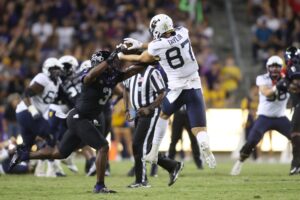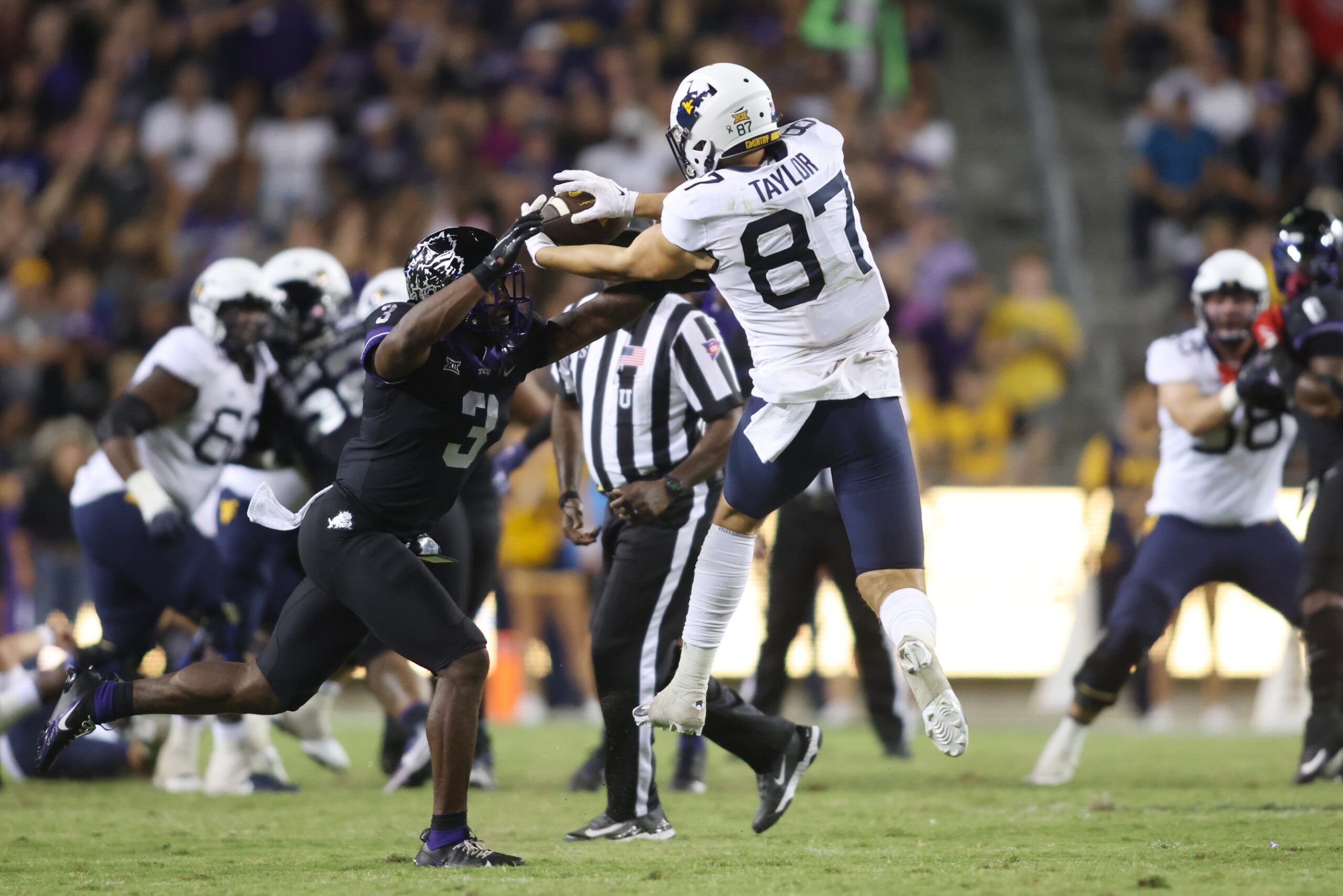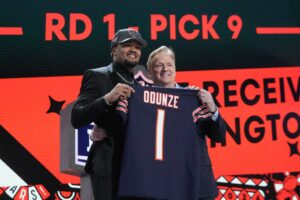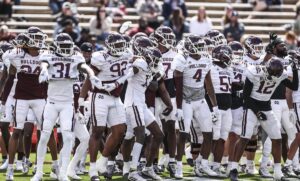After earning a gritty win over TCU, the West Virginia Mountaineers entered their bye week defying all expectations except for their own. Head Coach Neal Brown told reporters after the win over TCU, “Nobody believed in us. I don’t want to hear anybody on social media ‘Oh yea, I saw them being 4-1.'” Indeed, beginning this Summer, Brown developed a mantra for his team “14 Who?” referring to preseason predictions that the Mountaineers would finish 14th in the Big 12 this season. He said, point blank, that the team had a lot to prove. So far, so good, as we provide WVU’s bye week assessment.
WVU’s Bye Week Assessment
In some ways, it is strange to view West Virginia as a team with a 4-1 record heading into their bye week. After all, Brown was right. Very few expected the Mountaineers to be in this position. We certainly did not. That said, they still do not look like a 4-1 team statistically. Their offense ranks 82nd in terms of points per game in the nation through Week Five. Their defense ranks 34th. In the primary statistical categories, they find themselves in the top ten in just four: blocked kicks (5th), penalties per game (6th lowest), punt return defense (8th fewest opposing punt return yards per game), and time of possession (9th).
But let us talk about that time of possession number. That statistic is important to what Brown wants to do. So, too, is the penalties per game number. After the game, in praising his defense, Brown told the media, “People are going to say, ‘Well, they had 400 and whatever yards, y’all had 343,’ but we played clean football, [and] we held the ball for almost 33 minutes in the game.” Those things matter.
Since his arrival, Brown sought to build the Mountaineers into a blue-collar, physical, run-first team. He saw some other Big 12 teams pivoting, and he wanted to do it better. Indeed, Brown made no secret about it. A few things derailed those designs in his first several years, and, as a result, the fan base, going into the season, had lost complete confidence in Brown. While those fans still seem reluctant (and with justifiable reason), the ways Brown has preached for his team to control its own destiny since he arrived in Morgantown are finally starting to translate on the field. This should give room for optimism.
The First Signs of Optimism?
We wrote countless times over the last few years that West Virginia lost a game due to stalling drives as a result of avoidable penalties and mistakes. That is why the penalties per game number jumps out so readily. The program found itself in the bottom third of the country a few times under Brown. He knows that in order to run this style of play, his team has to limit mistakes and big plays. This is the first year the team has limited those mistakes and big plays, and, more than anything else, that is the difference between a 1-4 team and a 4-1 team.
Over the last three seasons, we count seven games where West Virginia lost either by a single score or as a result of one bad mistake. If you reverse those fortunes, West Virginia finishes 2020 at 8-2, 2021 at 9-4, and 2022 at 7-5. That looks a lot better than the 6-4, 6-7, and 5-7 records the Mountaineers actually owned. What do all of those games have in common? Big mistakes and ill-timed penalties stalling drives or keeping opposing teams’ drives alive underlie them all.
We can look at this season and say the opposite in some ways. In single-score games, West Virginia enters the bye week at 2-0. In prior years, those turn to losses, and we see a dejected 2-3 team with a red hot seat for Brown. The main difference is that the offense, even if it has not put up chunk yards and scored in bunches, does just enough to keep its defense fresh and keep high-octane opposing offenses off the field. That 2-0 record in single-score games, in other words, is no accident. This fact should give us our first sign of optimism for WVU’s bye week assessment.
What Else is Going Well?
In addition to special teams being among the best in the nation, time of possession favoring the Mountaineers, and discipline showing up in the box score in terms of fewer and fewer penalties, what else is going well for the Mountaineers? Defensively, they have played extremely well in the second half, as close to lights-out football as you will see, in fact.
The ingredients in the sausage are interesting, too. They rank 11th in opposing teams’ 3rd down conversion rate, so they’re getting off the field when they need to. They surrender the 38th fewest rushing yards per game, so they are keeping opposing rushers in front of them. The Mountaineers’ pass defense has improved, too. It ranks just outside the top 50 at 58th. The red zone defense ranks 40th in the nation. The Mountaineers are also making big plays, ranking 29th in the nation in tackles for loss.
West Virginia also has a neutral figure on turnover margin. They certainly let three or four turnovers get away from them against TCU, but they are being careful with the ball themselves. In other words, when they play at their worst, the Mountaineers are limiting the damage. This is something Brown has preached for the last two years. He worried that his team could play extremely well but when they were at their worst, the team played as badly as anyone in the country. They saw enough lopsided losses in the last two years to prove that out.
So far, WVU’s worst isn’t terrible, even if its best is just good enough to win. Ask Minnesota and Iowa fans how well “just good enough” can be.
What Comes Next?
To conclude WVU’s bye week assessment, we look forward. Unfortunately, the Mountaineers suffered through some injuries during their tilt with TCU. Trey Lathan had leg surgery in Fort Worth, and Aubrey Burks was carted off the field after a scary collision and stayed overnight in Fort Worth under observation. The extent of Burks’ injury remains unknown, though we expect Brown will address it in his press conferences next week. Lathan will be out for the remainder of the season.
Wyatt Milum, Tomas Rimac, Sean Martin, Hershey McLaurin, and several others left the game for at least some portion. Whether those injuries will linger into next week remains unknown. Either way, the bye week could not have come at a better time for an ailing Mountaineer team that needs to operate at full strength to continue playing this physical brand of football.
Assuming long-term injuries are limited, the Mountaineers’ remaining schedule lines up favorably. No doubt, former Mountaineer Coach Dana Holgorsen wants to get his Cougars back on track and secure a win over his old team next week. That said, Houston finds itself at 2-3 with losses to Rice, TCU, and Texas Tech. The Mountaineers then play a reeling Oklahoma State team at home, leaving West Virginia staring at a discrete possibility of traveling to Orlando in late October with a 6-1 record. They finish the season against BYU, Oklahoma, Cincinnati, and Baylor.
14 Who?
We certainly would not have said this prior to the season, but the Mountaineers suddenly have a legitimate chance to win between 7 and 10 games, the latter of which would put them well within striking distance to play for a Big 12 championship. To do so, West Virginia will need to keep its edge and continue in their belief that it is them against the world. “14 Who” would ring so much more sweetly as a season mantra playing for a Big 12 crown than it must already feel to a team proud to enter its bye week at 4-1.







